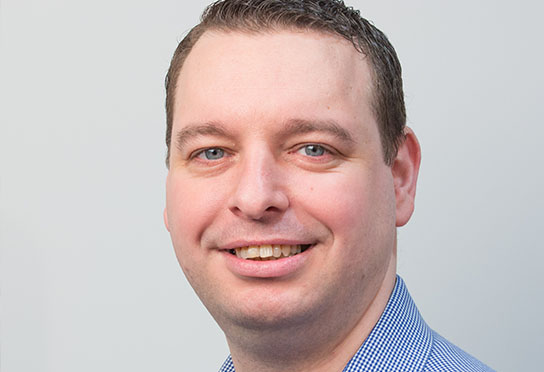
In the second of our series looking at our learning from COVID-19, Kevin Hunter, Associate Director for Patient Safety & Programme Delivery at West of England AHSN, reflects on his experiences ensuring safer care during the pandemic.

I have worked in the patient safety team at the West of England AHSN for over five years now and feel privileged to work alongside a diverse and inspiring group of people. Throughout this time, we have worked with colleagues at an organisational, regional and national level to improve safety and outcomes for the benefit of patients and their families or carers.
As the Patient Safety Lead for the AHSN, I like to think that as a region we have been very forward thinking and committed to our Patient Safety agenda. We are well supported by our regional Patient Safety Board. However, we never saw COVID-19 coming, and when it did, I like many others was worried about the impact on myself, my family, and the health and care providers I work with.
I knew from my own experience how busy the different patient-facing services could be and found myself wondering whether the safety improvement work we have supported across the region would be relevant in the context of this pandemic.
We help deliver national patient safety improvement programmes as well as our own local patient safety projects and it was clear not everything could continue during COVID-19. My focus increasingly shifted towards how we could support front-line colleagues to respond to the emerging pandemic, accelerating or changing current programmes and developing resources such as these for patient safety, especially as our national commission was refocused on a specific COVID-19 response.
We had already created a series of training films in partnership with Wessex AHSN and Health Education England, intended to support staff working in care providers to take observations. A suite of short 3-minute videos, these proved extremely popular when released at the start of the pandemic, especially the film about oxygen saturation measurements. This made sense as further evidence emerged about the effect COVID-19 appeared to have on people’s physiology.
There was a lot of ‘noise’ around the system throughout COVID-19 and many people with good intentions trying to help care providers respond. I can imagine this felt overwhelming to those providing direct care, especially in the community setting where the way care is commissioned and provided is quite different to that of a hospital.
We were being approached about supporting many differing priorities, including recognising the unwell patient, medicines safety, digital triage, or remote monitoring solutions. For me personally, it was a really testing time trying to balance the opportunities, tools, training, and resources I knew were available, with giving people the time and space to mobilise and respond to the pandemic.
One of the ways we tried to find this balance was by working together with the Wessex and South West AHSNs to expand our footprint. Whilst not new for AHSNs to work together like this, it was important that we aligned our work with that of the NHS England and NHS Improvement regional team and likewise individual Sustainability and Transformation Partnership leads. It was imperative that our approach aligned with theirs, including utilising individual command and control structures to highlight our RESTORE2 training offer to care homes. Care homes would often say they felt bombarded during this period and we didn’t want to add to the problem.
Previously we would have trained care homes or organisations in person, or held large-scale events. COVID-19 meant we had to rapidly redesign our whole approach and syllabus to be delivered within a virtual setting.
Our earlier work to ensure patients’ own wishes are clearly understood if they are unable to express them themselves saw rapid uptake. ReSPECT (Recommended Summary Plan for Emergency Care and Treatment) was used increasingly by primary care and care homes. Building on improvements made in Bristol and Gloucestershire, patients and residents were involved in the ReSPECT process: if patients are admitted without a ReSPECT form, they are now given the opportunity to have a discussion about their wishes whilst in hospital, which is then shared with their primary care team on discharge.
Much has been said in the news about people’s fear to reach out to healthcare services and one area where we saw this was within our maternity and neonatal Safety Improvement Programme. Helping people to feel safe and encouraging them to access services was a significant topic at our virtual, weekly regional learning and sharing meetings. I had a personal experience of this when trying to convince a family friend to book a much needed GP appointment.
My background is in the Royal Air Force and its motto is per ardua ad astra or through adversity to the stars. This really resonated with me over the last few months as I’ve seen friends and colleagues respond to this pandemic, despite their own fears and concerns.
I look back at everything we’ve achieved in such difficult and challenging circumstances and can’t help but feel proud that we contributed and helped make a difference. I would like to say a big thank you to everyone across our entire health and social care system, and especially my colleagues across the West of England.
I wish you and your families all the best and stay safe.
In the first of this blog series, our Chief Executive Natasha Swinscoe explores how healthcare is changing to manage COVID-19, and considers the factors that helped those on the front-line respond quickly and effectively. Read it here.
Coming up in the next blog of this series, we explore how collaboration is key and how this really works when focussed around common aims. Director of Service and System Transformation Kay Haughton explains more about our offer to help spread a stratification tool to support shielded patients with long-term conditions. Read it here.
Posted on September 16, 2020 by Kevin Hunter, Associate Director for Patient Safety & Programme Delivery, West of England AHSN





